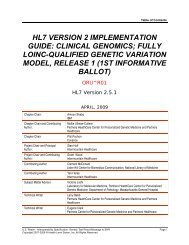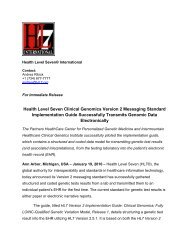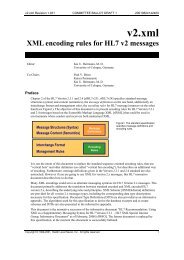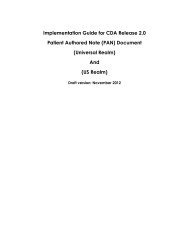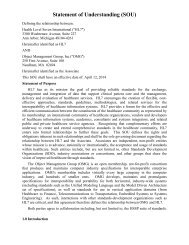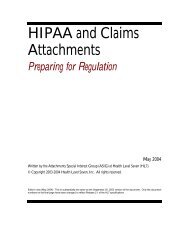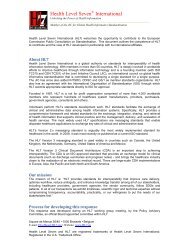HL7 CDA R2 AIS Implementation Guide
HL7 CDA R2 AIS Implementation Guide
HL7 CDA R2 AIS Implementation Guide
Create successful ePaper yourself
Turn your PDF publications into a flip-book with our unique Google optimized e-Paper software.
<strong>HL7</strong> Additional Information Specification <strong>Implementation</strong> <strong>Guide</strong><strong>CDA</strong><strong>R2</strong><strong>AIS</strong>0000R030has a data type. Data types define the meaning (semantics) of values that can be assigned to anelement. Meaningful exchange of data requires that we know the definition of values soexchanged. This is true for complex "values" such as business messages as well as for simplervalues such as character strings or integer numbers.The value tables in the Additional Information Specifications specify a data type for the valuerepresented by each LOINC code. Figure 2.9-1 above provides an example of these tables.The following subsections of this specification describe how each data type is formatted in a<strong>CDA</strong> attachment. The approach varies according to the data type. For string (ST) and text (ED)the format used for interpretation by the computer is the same as the format used for a human.For all other data types the sender includes the information twice: once in natural language forhuman decision making and once in structured markup using elements in the .3.7.2 General Rules for All Data TypesWhen an <strong>AIS</strong> asks for information of a specific data type, the information contained within thatdata type needs to be available in human-readable form. When using the computer-decisionvariant, the information must also be available in machine-readable form in an in a or in an element in the header of the .3.7.3 Encapsulated Data (ED) Data TypeThe ED data type is used to capture narrative text. Where a component or answer part in anattachment is of the ED data type, it is expected to appear as in a , in both thecomputer- and human-decision variants, and shall be clearly identified with a human-readable. In the computer-decision variant, the element shall have a element thatidentifies it using the LOINC code of the answer component.CDV Example:HISTORY OF PRESENT ALCOHOL/SUBSTANCE ABUSEPatient is a 15-year old white male who reports consumingalcohol daily since age thirteen. He claims that his current alcohol consumption hasbeen from various beverages averaging in excess of 500 ml of ethanol per day. Thereis evidence of substantial acquired physiological tolerance for alcohol. He droppedout of school in October and reports blackouts and episodes of combative behavior.XML parsers will normalize white space in P<strong>CDA</strong>TA, so that the example above and the examplebelow would be processed the same. Browsers and other rendering programs will usually wordwrapthe text according to the dynamic size of the window or page that is the target.HISTORY OF PRESENT ALCOHOL/SUBSTANCE ABUSEPatient is a 15-year old white male who reports consuming alcohol dailyPage 58March 2007Copyright © 1998-2007Health Level Seven, Inc. All rights reserved.Release 3.0 Draft Standard




